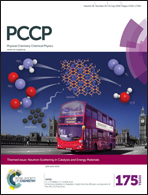Molecular dynamics investigations of regioselectivity of anionic/aromatic substrates by a family of enzymes: a case study of diclofenac binding in CYP2C isoforms†
Abstract
The CYP2C subfamily is of particular importance in the metabolism of drugs, food toxins, and procarcinogens. Like other P450 subfamilies, 2C enzymes share a high sequence identity, but significantly contribute in different ways to hepatic capacity to metabolize drugs. They often metabolize the same substrate to more than one product with different catalytic sites. Because it is challenging to characterize experimentally, much still remains unknown about the reason for why the substrate regioselectivity of these closely related subfamily members is different. Here, we have investigated the structural features of CYP2C8, CYP2C9, and CYP2C19 bound with their shared substrate diclofenac to elucidate the underlying molecular mechanism for the substrate regioselectivity of CYP2C subfamily enzymes. The obtained results demonstrate how a sequence divergence for the active site residues causes heterogeneous variations in the secondary structures and in major tunnel selections, and further affects the shape and chemical properties of the substrate-binding site. Structural analysis and free energy calculations showed that the most important determinants of regioselectivity among the CYP2C isoforms are the geometrical features of the active sites, as well as the hydrogen bonds and the hydrophobic interactions, mainly presenting as the various locations of Arg108 and substitutions of Phe205 for Ile205 in CYP2C8. The MM-GB/SA calculations combined with PMF results accord well with the experimental KM values, bridging the gap between the theory and the experimentally observed results of binding affinity differences. The present study provides important insights into the structure–function relationships of CYP2C subfamily enzymes, the knowledge of ligand binding characteristics and key residue contributions could guide future experimental and computational work on the synthesis of drugs with better pharmacokinetic properties so that CYP interactions could be avoided.


 Please wait while we load your content...
Please wait while we load your content...